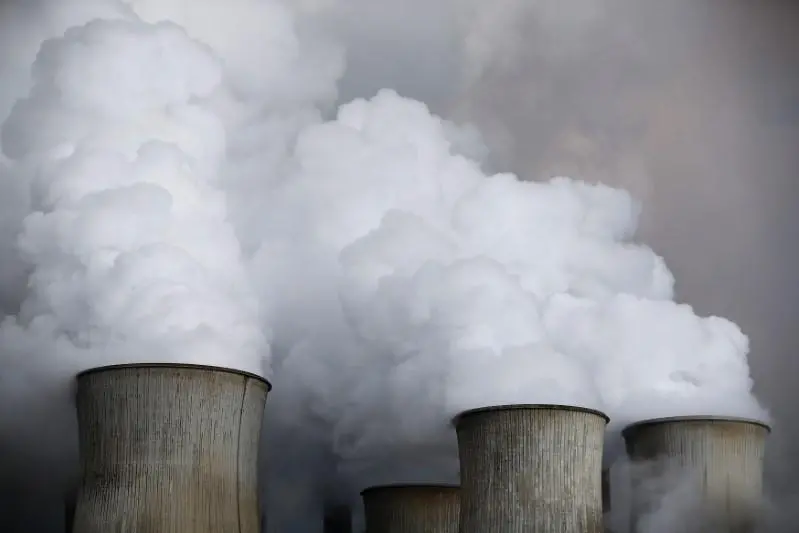PHOTO
With the COP26 climate change summit due to open in Glasgow in barely a few weeks, negotiations are heating up as countries try to establish their own red lines and boundaries over what is acceptable in terms of climate emissions norms and practices.
One of the hottest topics at COP26, and long after the two-week forum has ended, will be the EU’s carbon border tax, a highly controversial levy included in the EU Green Deal announced in July 2021. This aims to cut carbon emissions by 55 percent by 2030 compared to 1990 levels and for the entire community to become carbon neutral by 2050.
An integral part of the Green Deal is the carbon border adjustment mechanism — a carbon tax in layman’s terms. The EU plans to impose this on all imports of goods as well as services in order to ensure a level playing field for its own industry, which Brussels says will be unfairly penalized by tighter environmental and emissions standards.
EU leaders have justified the tax, which also will be applied on foreign airlines arriving into the bloc, as a countermeasure to balance out poorer environmental norms in other nations. However, the tax has already brought loud protests by almost every non-EU nation, notably developing countries, which say that Brussels is simply erecting another barrier to trade and providing unfair assistance to its own businesses.
The EU is trying to justify the carbon tax by saying that its measures to protect the environment are among the most advanced in the world and that its companies have to adhere to severe emission norms, which impose a high cost on production due to conditions such as use of recycled materials, energy efficiency and higher taxes on polluting materials. It goes on to say that producers in other countries have a significant and undue advantage in terms of cost of manufacturing due to more lax norms for environment protection and lower or zero taxes on pollution.
There is no doubt that the EU is trying to cut its emissions significantly from 1990 levels, while many developed nations have made only token commitments and, at times, failed to meet even these goals. Data from the European Commission shows that EU greenhouse gas emissions in 1990 stood at 5,669 million tons. These have fallen by over 24 percent in the past 30 years and EU’s total emissions now stand at 4,067 million tons, a significant achievement for any major emitter in this time frame.
The EU has set a target of 55 percent reduction from 1990 levels by 2030, which means that total emissions will stand at 2,551 million tons — an average drop of 151 million tons every year from now till the target date.
Indeed, compared with other developed regions, the EU has achieved an outstanding drop in the past 30 years. In 2019, emissions by the US, the biggest historical polluter, totaled 6,558 million tons, an increase on the 1990 figure of about 6,442 million tons. Neighboring Canada saw a 21 percent rise from 1990 levels and its total greenhouse gas emissions in 2020 stood at 729 million tons, up from 603 million tons.
The EU could perhaps justify its carbon tax on imports using these and a few other rich countries as examples of how the rest of the world has failed to make any effort to reduce emissions and, in fact, has allowed industry to pollute even more than before.
But, unfortunately, the EU’s carbon tax is not limited to rich countries. Documents released so far speak of a global application, with the same level of tax for similar products from anywhere in the world. That means developing countries exporting to the EU could take a significant hit — one reason the carbon tax has sparked anger in countries with significant trade levels with the EU.
The developing countries raise objections on multiple grounds. First is the globally accepted and acknowledged principle of common but differentiated responsibilities, which means that while all countries are responsible for taking measures to protect the environment, they are not equally responsible. Under this time-tested and successful principle, wealthy countries need to make a much greater contribution in cutting emissions, while no such responsibility can be placed on poorer nations simply because for over 200 years since industrialization began, rich countries have been the major source of pollution.
For instance, from 1850 to 2007, the US is estimated to have emitted 339,174 million tons of carbon dioxide, Germany about 81,194 million tons, and so on. In comparison, India has produced 28,824 million tons, Democratic Republic of Congo 681 million tons and South Africa 521 million tons.
On a per capita basis, current as well as historical emissions show the extent to which the rich nations, including the EU, have been responsible for global warming and climate change. Hence, before the EU applies any carbon tax on developing nations it ought to take a look in the mirror.
In 2019, the EU per capita emission stood at 6.56 tons, while Democratic Republic of Congo registered 0.3 tons and India 1.91 tons. The developing countries are right in seeking comparisons based on population as well as historical emissions in order to reach a conclusion about the responsibility of each nation and the steps each should take to help curb global warming.
It is not just the poor or developing nations that have serious objections to the EU’s proposed tax. The levy will clearly fall foul of the World Trade Organization rules for global trade, and if EU applies a tax based on its own calculations of what the producers in other countries have to do to meet their local norms, it will be sure to start an unprecedented global trade war.
Certainly, it is important for all countries to contribute to the battle against climate change and nobody is claiming that it is only the EU’s responsibility. It may be time to institute a cross-border carbon tax as well. But such moves can never be unilateral. There has to be a global agreement on such taxes, which should be fair and sustainable, rather than arbitrary moves based primarily on protectionism and national interest, and justified by hunches, biases and estimates.
- Ranvir S. Nayar is managing editor of Media India Group, a global platform based in Europe and India, which encompasses publishing, communication and consultation services.
Copyright: Arab News © 2021 All rights reserved. Provided by SyndiGate Media Inc. (Syndigate.info).





















